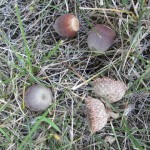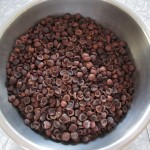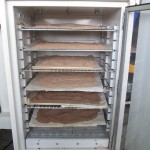It was that dist inctive sound of something small and dense falling through the tree canopy and landing on the forest floor that caused me to hop on my bike and head to town. After riding or walking through the local park and so
inctive sound of something small and dense falling through the tree canopy and landing on the forest floor that caused me to hop on my bike and head to town. After riding or walking through the local park and so me friends’ yards, checking the ground around dozens of oak trees, I was surprised to find that only 1 tree had what I was looking for – large, healthy acorns! But one was all I needed. One productive tree can produce way more acorns than I need. I returned the next day with a bucket in hand and gathered 4 gallons of acorns in a little over an hour.
me friends’ yards, checking the ground around dozens of oak trees, I was surprised to find that only 1 tree had what I was looking for – large, healthy acorns! But one was all I needed. One productive tree can produce way more acorns than I need. I returned the next day with a bucket in hand and gathered 4 gallons of acorns in a little over an hour.
Why all the excitement over acorns?
We all know that acorns are an important food source for animals (squirrels, deer, bear, and weevils) as they prepare for the cold winter months, but few people realize that acorns are a good source of both fat and protein that are worthy of human consumption. Acorns can be ground into a delicious, healthful flour that can be added to almost anything. They also contain tannic acid, an ast ringent that works wonders on drying and closing wounds that don’t seem to want to heal on their own.
ringent that works wonders on drying and closing wounds that don’t seem to want to heal on their own.
Acorns are easily collected from the ground as they fall off the trees in the fall (September – October). The sooner they are collected, the less damage will have been done to them by acorn worms (weevil larvae). A small, round hole in the shell means that the larva(e) have eaten their fill and made their exit. I leave these ones on the ground. I als o leave any nuts that look anything other than “perfect”, since those with scarring on them usually still have worms inside.
o leave any nuts that look anything other than “perfect”, since those with scarring on them usually still have worms inside.
There are many ways to shell acorns but I have so far found the easiest being to roast them in an oven or next to a fire until the shells crack easily when pressed with a hard object. (Roasting also takes care of any worms that might be in them.) I like to put the acorns on a flat surface, place a wooden spoon on top (concave side down) and then whack or press the spoon with my hand. The spoon prevents pieces from flying all over the place. Once shelled, they can be ground into flour. I put them through a food processor and then transfer them to a blender. (I do not  recommend putting dried acorns in either appliance, as they make a dreadful racket and are very hard on the machines.) Even if the flour is not powder fine, it will work well in many recipes. I then spread the flour on a cookie sheet and dry it in the oven at a low temperature (or in a dehydrator). If it roasts a bit, that’s okay, too.
recommend putting dried acorns in either appliance, as they make a dreadful racket and are very hard on the machines.) Even if the flour is not powder fine, it will work well in many recipes. I then spread the flour on a cookie sheet and dry it in the oven at a low temperature (or in a dehydrator). If it roasts a bit, that’s okay, too.
I add acorn flour to muffins and pancakes (acorn-blueberry are  my favourite), usually in addition to the amount of flour already specified. If a recipe calls for nuts, add acorn flour instead. Muffins in which I used a large proportion of acorn flour to grain flour turned out quite tasty, but very dense (and ugly enough to cause others to politely decline the offer).
my favourite), usually in addition to the amount of flour already specified. If a recipe calls for nuts, add acorn flour instead. Muffins in which I used a large proportion of acorn flour to grain flour turned out quite tasty, but very dense (and ugly enough to cause others to politely decline the offer).
Instruction s for preparing acorn flour often include a step that involves removing the astringent tannic acid from the nuts, either by repeated boilings or cold-water leaching. It is important to know that there are two types of oak trees – red oaks and white oaks. Red oaks contain a very high concentration of tannic acid, which is very astringent and unpleasant to eat. With red oaks, the leaching process is very important. However, the bur oak (the only oak that grows in Manitoba) is a type of white oak. White oaks have a much lower concentration of tannic acid and I have found through experience that acorns gleaned from the bur oak do not require this extra process.
s for preparing acorn flour often include a step that involves removing the astringent tannic acid from the nuts, either by repeated boilings or cold-water leaching. It is important to know that there are two types of oak trees – red oaks and white oaks. Red oaks contain a very high concentration of tannic acid, which is very astringent and unpleasant to eat. With red oaks, the leaching process is very important. However, the bur oak (the only oak that grows in Manitoba) is a type of white oak. White oaks have a much lower concentration of tannic acid and I have found through experience that acorns gleaned from the bur oak do not require this extra process.
Tannic acid collected by boiling oak bark, acorn shells or the acorns, themselves, works wonders for drying out and closing open wounds, poison ivy sores and other skin eruptions. With repeated applications of tannic acid tea, results can be seen in very little time. I used a strong tannic acid tea to help close a deep gash I had in my leg. In less than an hour, the effects were indisputable. I also use it to soothe sore feet after walking barefoot through places where I should have known better.
I always save at least a gallon of acorn shells to use for this purpose. They can also be used to make a tea that will sustain kombucha or manchurian “mushrooms”. With the addition of wild ginger root and Labrador tea, you can make your very own ginger-ale-flavoured drink!
Tannic acid is so called because of its history as a hide tanning agent. For this purpose, slabs of oak bark were soaked in water. Animal hides were added to the brew and allowed to soak for several months.




